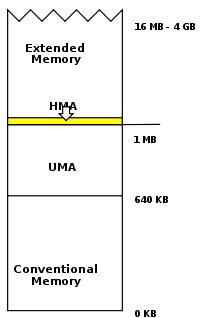Extended memory is virtual memory, Expanded memory is actual physical memory, such as a chip or ram using an expansion card with bank switched memory modules. .
One way to add more memory to your system is to install extended memory. Extended memory is available only on systems with 20286 or higher processors. (Many 80286 and 80386 computers come with 640K of conventional memory and 384K of extended memory.)
To use extended memory efficiently, you should install a program called an extended-memory manager. An extended memory manager prevents different programs from using the same part of extended memory at the same time. The extended-memory manager also makes it easier to use extended memory. MS-DOS includeds the extended memory manager HIMEM.SYS. HIMEM conforms to the Lotus/Intel/Microsoft/AST eXtended Memory Specification (XMS) version 2.0, which specifies a standard way for programs to use extended memory cooperatively.
expansion if you use Microsoft Windows version 3.0 or later, since Windows works best with extended memory.
NOTE If you have a 80386 or80486 system with extended memory and you use programs that can take advantage of expanded memory, you might want to install EMM386.EXE. EMM386 is a device that can use extended memory to simulate expanded memory.
Another way to add memory in excess of 640K to your system is to install expanded memory.
Extended memory
In DOS memory management, extended memory refers to memory above the first megabyte of address space in an IBM PC or compatible with an 80286 or later processor. The term is mainly used under the DOS and Windows operating systems. DOS programs, running in real mode or virtual x86 mode, cannot directly access this memory, but are able to do so through an application programming interface called the eXtended Memory Specification (XMS). This API is implemented by a driver (such as HIMEM.SYS) or the operating system, which takes care of memory management and copying memory between conventional and extended memory, by temporarily switching the processor into protected mode. In this context the term "extended memory" may refer to either the whole of the extended memory or only the portion available through this API.
Extended memory can also be accessed directly by DOS programs running in protected mode using VCPI or DPMI, two (different and incompatible) methods of using protected mode under DOS.
